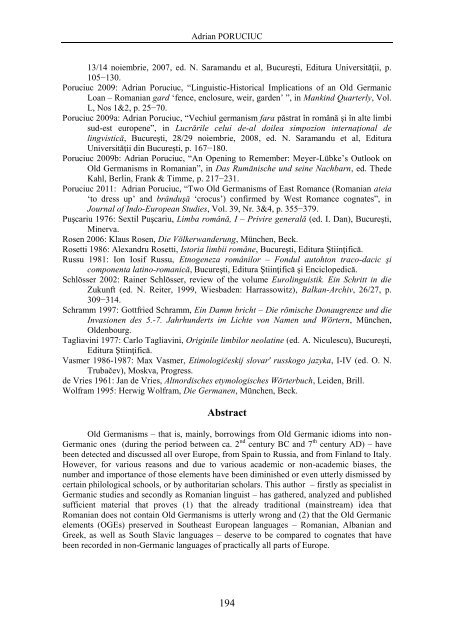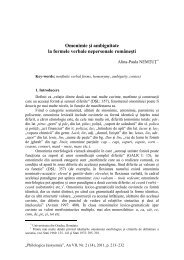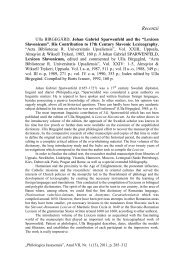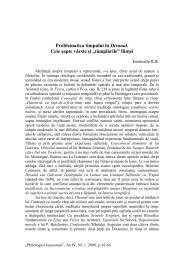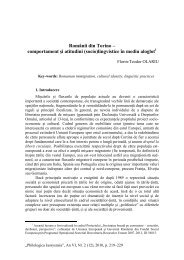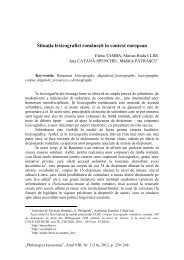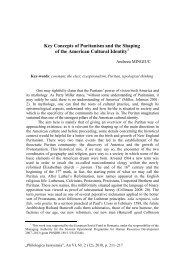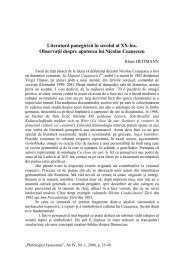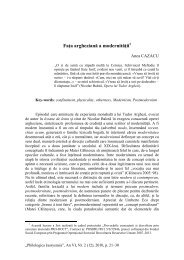O sutÄ de ani de cartografie lingvisticÄ româneascÄ - Philologica ...
O sutÄ de ani de cartografie lingvisticÄ româneascÄ - Philologica ...
O sutÄ de ani de cartografie lingvisticÄ româneascÄ - Philologica ...
Create successful ePaper yourself
Turn your PDF publications into a flip-book with our unique Google optimized e-Paper software.
Adrian PORUCIUC<br />
13/14 noiembrie, 2007, ed. N. Saramandu et al, Bucureşti, Editura Universităţii, p.<br />
105−130.<br />
Poruciuc 2009: Adrian Poruciuc, “Linguistic-Historical Implications of an Old Germ<strong>ani</strong>c<br />
Loan – Rom<strong>ani</strong>an gard ‘fence, enclosure, weir, gar<strong>de</strong>n’ ”, in Mankind Quarterly, Vol.<br />
L, Nos 1&2, p. 25−70.<br />
Poruciuc 2009a: Adrian Poruciuc, “Vechiul germ<strong>ani</strong>sm fara păstrat în română şi în alte limbi<br />
sud-est europene”, in Lucrările celui <strong>de</strong>-al doilea simpozion internaţional <strong>de</strong><br />
lingvistică, Bucureşti, 28/29 noiembrie, 2008, ed. N. Saramandu et al, Editura<br />
Universităţii din Bucureşti, p. 167−180.<br />
Poruciuc 2009b: Adrian Poruciuc, “An Opening to Remember: Meyer-Lübke’s Outlook on<br />
Old Germ<strong>ani</strong>sms in Rom<strong>ani</strong>an”, in Das Rumänische und seine Nachbarn, ed. The<strong>de</strong><br />
Kahl, Berlin, Frank & Timme, p. 217−231.<br />
Poruciuc 2011: Adrian Poruciuc, “Two Old Germ<strong>ani</strong>sms of East Romance (Rom<strong>ani</strong>an ateia<br />
‘to dress up’ and brânduşă ‘crocus’) confirmed by West Romance cognates”, in<br />
Journal of Indo-European Studies, Vol. 39, Nr. 3&4, p. 355−379.<br />
Puşcariu 1976: Sextil Puşcariu, Limba română, I – Privire generală (ed. I. Dan), Bucureşti,<br />
Minerva.<br />
Rosen 2006: Klaus Rosen, Die Völkerwan<strong>de</strong>rung, München, Beck.<br />
Rosetti 1986: Alexandru Rosetti, Istoria limbii române, Bucureşti, Editura Ştiinţifică.<br />
Russu 1981: Ion Iosif Russu, Etnogeneza românilor – Fondul autohton traco-dacic şi<br />
componenta latino-rom<strong>ani</strong>că, Bucureşti, Editura Ştiinţifică şi Enciclopedică.<br />
Schlösser 2002: Rainer Schlösser, review of the volume Eurolinguistik. Ein Schritt in die<br />
Zukunft (ed. N. Reiter, 1999, Wiesba<strong>de</strong>n: Harrassowitz), Balkan-Archiv, 26/27, p.<br />
309−314.<br />
Schramm 1997: Gottfried Schramm, Ein Damm bricht – Die römische Donaugrenze und die<br />
Invasionen <strong>de</strong>s 5.-7. Jahrhun<strong>de</strong>rts im Lichte von Namen und Wörtern, München,<br />
Ol<strong>de</strong>nbourg.<br />
Tagliavini 1977: Carlo Tagliavini, Originile limbilor neolatine (ed. A. Niculescu), Bucureşti,<br />
Editura Ştiinţifică.<br />
Vasmer 1986-1987: Max Vasmer, Etimologičeskij slovar' russkogo jazyka, I-IV (ed. O. N.<br />
Trubačev), Moskva, Progress.<br />
<strong>de</strong> Vries 1961: Jan <strong>de</strong> Vries, Altnordisches etymologisches Wörterbuch, Lei<strong>de</strong>n, Brill.<br />
Wolfram 1995: Herwig Wolfram, Die Germanen, München, Beck.<br />
Abstract<br />
Old Germ<strong>ani</strong>sms – that is, mainly, borrowings from Old Germ<strong>ani</strong>c idioms into non-<br />
Germ<strong>ani</strong>c ones (during the period between ca. 2 nd century BC and 7 th century AD) – have<br />
been <strong>de</strong>tected and discussed all over Europe, from Spain to Russia, and from Finland to Italy.<br />
However, for various reasons and due to various aca<strong>de</strong>mic or non-aca<strong>de</strong>mic biases, the<br />
number and importance of those elements have been diminished or even utterly dismissed by<br />
certain philological schools, or by authoritarian scholars. This author – firstly as specialist in<br />
Germ<strong>ani</strong>c studies and secondly as Rom<strong>ani</strong>an linguist – has gathered, analyzed and published<br />
sufficient material that proves (1) that the already traditional (mainstream) i<strong>de</strong>a that<br />
Rom<strong>ani</strong>an does not contain Old Germ<strong>ani</strong>sms is utterly wrong and (2) that the Old Germ<strong>ani</strong>c<br />
elements (OGEs) preserved in Southeast European languages – Rom<strong>ani</strong>an, Alb<strong>ani</strong>an and<br />
Greek, as well as South Slavic languages – <strong>de</strong>serve to be compared to cognates that have<br />
been recor<strong>de</strong>d in non-Germ<strong>ani</strong>c languages of practically all parts of Europe.<br />
194


